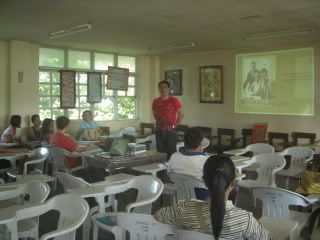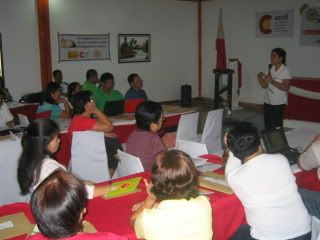
28 October 2010
27 October 2010
the story behind my PA and Social Change class

Few semesters ago, when Dr. Omas-as offered me the subject Public Administration and Social Change, my first question was: Is there a book that I could use as reference? She told me to ask Ma’am Nilds Cosare who handled the course the previous semester. Ma’am Nilds, bless her kind soul, gave me a photocopy of Stephen Vago’s “Social Change.”
As it is, Vago’s book is good because it draws attention to the characteristics, processes, and perspectives of social change. But the rub is, these exciting topics in Sociology are not linked with Public Administration.
Uh-uh!
That semester I taught PA and Social Change with eyes wide shut, groping for materials in the Internet that would help me and my students navigate through unfamiliar territory. I texted friends who texted their friends in UP and other SUCs for materials that I could sink my teeth into.
Zero. Nil. Zilch.
And then just like that I realized that the words creativity and improvisation were coined for a purpose. And just like that, me and my student stepped out of academic limbo, and into the light.
But until now, I still get this feeling that I could have done more. And Euli Ann, one of my exceptional students, echoed this sentiment when she recently posted a comment on my FB wall, thus: I can't imagine what the final exam for PA and Social Change be; kamatayon na ngani yadto sa una na waray klaro na reference materials, uno pa kaha kuman na pan Harvard?
But that’s getting ahead of the story.

Dr. Omas-as offered me again PA and Social Change last semester. Here’s my chance at self-redemption, I remember telling myself; eagerly I agreed even if it was in the time slot I eschew---1:00 to 4:00 PM.
And so it went that while my students reported on Vago’s first five chapters, I was busy befriending Google and coining every conceivable keyword before dragging the mouse.
Again, nada.
Time was running out. My students were already asking for their topics. And I began to feel the symptoms of Carpal Tunnel Syndrome in the heel of my palm.
Then one rainy afternoon, just when I was about ready to give up, Google smiled at me and gave me a book title: The Social Construction of Public Administration (Interpretive and Critical Perspective) by Jong S. Jun.
Immediately after the Google revelation, I sent text messages to my friends in the Metro to check if the book was available locally. It wasn’t. Not wanting this time to filch it from Torrent, I faced my FB wall and typed away my frustration. Five minutes later, a miracle happened: an angel from North Hills, California commented that all I needed to do was to say the word and she’d send the book pronto.
Well, I said the word.
Just a short digression: The angel’s name is Carol Macaranas. My classmate at the University of San Carlos, Carol has that rare combination of beauty and brain, with a heart as big as the State of Texas! She has also put some books about writing on my shelves and an oxblood Armani Exchange timepiece on my wrist!

Two weeks later, the book arrived. And my PA and Social Change class was never the same again!

My PA and Social Change class last semester will be best remembered as a motley group with intellectual gravitas rarely found in grad school. Take for instance Ernie Gultiano and Ronelyn Pinalba exchanging incisive comments, leaving everybody wishing silently for the two not to stop; or Eleonesto Dumagan needling the reporter for some contradictions; or Cheryl Elpa breaking into a smile before doing a rebuttal; or Francis Miranda mouthing legal jargons as though Mirriam Santiago were his Mom; or Ferdinand Denso doing a kilometric commentary in a voice so well-modulated it would make Mike Enriquez weep of envy; or Ermin Buhion hurling a couple of philosophical questions to nobody in particular; or Mr. Alas sharing his thoughts in an unassuming way that was his signature.
Gee, I loved that class.
26 October 2010
my HRM class

I’ve been teaching in the graduate school of Surigao del Sur Polytechnic State College (now Surigao del Sur State University) for many years now. I may not remember the names of all my students, but I do remember all the memories.
I have my fair share of “unwanted” subjects. And by that I mean subjects that are difficult to teach either because it’s the first time they’re being offered or there are no available reference materials in an otherwise book-challenged library. I don’t mind getting these subjects though, because I look at them as windows of opportunity to expand my academic horizon.
Last semester, I was lucky to have been given two subjects that became the most enjoyable in my teaching history bar none! Both had more than 20 students who unabashedly shared their thoughts.
Just a context: The number of students in a class does not dictate my teaching strategy or my brand of English. But I prefer more enrollees because by doing the same amount of effort, I can impact more, thus enhancing the multiplier effect of knowledge sharing.

My Human Resource Management (HRM) class had an interesting mix because students came from different programs—MaEd, MPA, and MBA. If that’s not a good recipe for interaction, then I don’t know what is!
There was a palpable sense of healthy competition. When MaEd students gave their reaction to a topic, it was certain their MPA and MBA counterparts would spill their guts too. More than amused, I was grateful for this because it enhanced greatly the quality of learning we had every meeting.
But more than anything else, I valued their sharing about how HRM is being implemented in their offices. I couldn’t bare it here as we had an agreement to leave all discussions in the classroom, but suffice it to say that they gave me a snapshot of HRM in the Philippine bureaucracy. And I tell you, the picture is far from being postcard-perfect.

Given my reputation as “horror” teacher, my students, for sure, had the creeps. But judging from the way their faces lit up every time I did a synthesis at the end of every report, and the way they laughed each time I threw them a funny line or situation, which was often, I’m sure it wasn’t as creepy as they thought.
I will miss this class.
24 October 2010
not so good news
we had our final exams last saturday and we agreed to post here the aliases of those who will take the removal exam, the schedule of which will be announced later.
HUMAN RESOURCE MANAGEMENT
1. Heal
2. Thata B.A.
3. Moonlight Lady
4. GAC
Special mention goes to Sheila L. Portillo-Buhion and Emily Nimes for exceeding my expectations.
PUBLIC ADMINISTRATION AND SOCIAL CHANGE
1. AMC
2. LEM
3. DARV
4. Tweety
5. Loverboy
6. Khlundysthyn
7. Megan's
8. Lee
9. Tsingkay
10 FCM
11. JCL
12. LBS
13. DLR
14. Syo-syo
15. Dark Man
16. Munch
17. Pink
Special mention goes to Ernie Gultiano and Eleonesto Dumagan for exceeding my expectations.
HUMAN RESOURCE MANAGEMENT
1. Heal
2. Thata B.A.
3. Moonlight Lady
4. GAC
Special mention goes to Sheila L. Portillo-Buhion and Emily Nimes for exceeding my expectations.
PUBLIC ADMINISTRATION AND SOCIAL CHANGE
1. AMC
2. LEM
3. DARV
4. Tweety
5. Loverboy
6. Khlundysthyn
7. Megan's
8. Lee
9. Tsingkay
10 FCM
11. JCL
12. LBS
13. DLR
14. Syo-syo
15. Dark Man
16. Munch
17. Pink
Special mention goes to Ernie Gultiano and Eleonesto Dumagan for exceeding my expectations.
19 October 2010
doing a lecture on technical writing

At least they didn’t give me a look like I was speaking in tongues. And it was all I needed to make it through.
I recently got invited to do a lecture on technical writing as part of the workshop organized and facilitated by the Department of Interior and Local Government. Participated in by department heads from Surigao del Sur’s 18 towns and one city, my lecture was intended to make it easier for participants to write their respective comprehensive development plan, the workshop output.
That I got the job was a complete surprise. For one, I have no track record with DILG. Second, I didn’t know Provincial Director Pedrito P. Alacaba as he was assigned in Tandag for barely two months. But as it turned out, Taptap---PD Alacaba’s staff from Kitcharao and my first-time student in grad school---suggested getting me. Well, talk about Taptap’s clairvoyance (for how else did he know I was into that stuff?) and PD Alacaba’s leap of faith! But really I’m grateful; otherwise I wouldn’t have snagged a “racket” that netted me half of my Honda Jazz’s monthly amortization.
But what’s Jazz got to do with it?

My call slip said: 28 September, 8:30 AM; Kansilad Beach Resort, Lianga. I woke up ahead of my alarm clock, bathed, ate, and left at 6:45.
There was a promise of rain in the Tuesday skies. And as I drove, I felt a sense of unease: It was my first long drive and I was alone. But by the time I reached La Paz, I began to loosen up. And from then on, zipping past five towns was a breeze, though it helped that Christian Bautista bouyed me up with melodious thoughts about chasing rainbows, spinning dreams, and things that fade as swiftly as the ripples disappear.
I reached Kansilad while the participants were having breakfast. The room lit up with familiar faces: friends from way back, former graduate students, acquaintances whose names were already beyond the pale of short-term memory.
I fixed myself coffee while Taptap scanned my memory stick. Some participants came up to me and said things I’m sick and tired of hearing, you know, that they had the jitters when they knew I was coming. No, not to do a lecture but to critique their work.
I’ve said it before and I’ll say it now: If hating mediocrity is a crime, then sue me! But don’t take it against me if I maintain a standard of excellence because that’s how I do my enterprise. It’s not about me and my ego, nor it is about you and your insecurities; it’s all about aspiring for excellence, no more, no less!
But I digress!

How do you cram a lecture about writing---technical communications at that---in just three hours? Customize it.
Because DILG had a template and the participants had already the data to flesh out their plans, I was left to focus on form. And I did that by hand-holding the participants as we waded through my PowerPoint presentation that included, among others, audience orientation, legibility, readability, comprehensibility, clarity of expression, simplicity of language, vocabulary, grammar and elements of style.
But beyond syntax and semantics, I talked about common writing pitfalls that make a development plan hefty and difficult to read. I also shared ways on how to do it with less flab.
While the participants enhanced the lecture with their questions and interaction, most of them declined to present a sample of their work for critiquing. And so it was early pack-up for me!
On my way home Nina was telling me about love moving in mysterious ways, but my mind was busy assessing the just concluded activity. And once again, it reinforced what I’ve known for so long: The best thing about giving a lecture is that you end up learning more. And when you get paid for it, it feels kinda obscene. Because if like me you enjoy talking before a crowd, it's like getting paid for eating your favorite ice cream.
17 October 2010
Sola Gratia

Tago is blessed with natural attractions but only a few, if at all, have been developed. But recently an inland resort has opened in Pamugsukan, Gamut that is fast attracting tourists. It’s called “Sola Gratia.”
Sola gratia is Latin for “grace alone,” a teaching that salvation comes by God’s grace alone and not as an unearned favor from Him. The name is apt because the resort is one of the amenities of a bible school. In fact, it was put-up so that the school can have funds to support partly its students who study there for free.
Sola Gratia is a pocket forest that exudes a notion of all things primitive: vine-curtained trees, massive boulders limned by cascading waters, a murmuring creek and a colorful bed of flowers.

At the center of Sola Gratia are two pools: one for kids, one for adults. Not necessarily mutually exclusive, these pools contain emerald water siphoned from a natural source---somewhere up there must be a spring or a falls---and discharged into a creek that snakes all the way to Tago River. In short, the water is forever flowing, fresh and clean!


At present, there’s only one cottage. But a small group can camp out under the caretaker’s high-heeled lodge decked with tables and chairs. Other than those two, campers have to content themselves with just long tables and benches. But for sure that’s only for now.
Sola Gratia’s area is limited but its unique contour can be exploited to offer thrills to daring souls. One thinks of rappelling, rock climbing, vine-swinging, and crossing a hanging bridge from one tree house to another. Here's praying the pastor-owner would spend time learning what to do with Sola Gratia’s natural advantages!

From Tago or Tandag, Sola Gratia is just a short tricycle commute away. It’s about 50 meters from the highway but one can drive down the narrow path straight to the gate.
Children and adults are asked to pay P10 and P20, inclusive of cottage fee. Night swimming is allowed from 6:00 to 9:00 o’clock at P30 each. Drinking alcohol and smoking are prohibited.

Subscribe to:
Comments (Atom)

